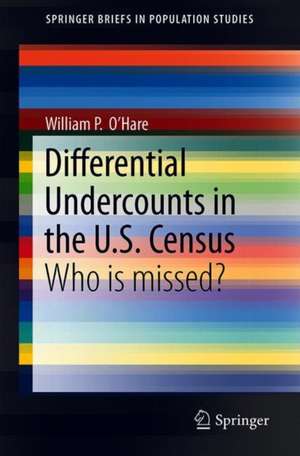Differential Undercounts in the U.S. Census: Who is Missed?: SpringerBriefs in Population Studies
Autor William P. O’Hareen Limba Engleză Paperback – 22 feb 2019
This open access book describes the differences in US census coverage, also referred to as “differential undercount”, by showing which groups have the highest net undercounts and which groups have the greatest undercount differentials, and discusses why such undercounts occur. In addition to focusing on measuring census coverage for several demographic characteristics, including age, gender, race, Hispanic origin status, and tenure, it also considers several of the main hard-to-count populations, such as immigrants, the homeless, the LBGT community, children in foster care, and the disabled. However, given the dearth of accurate undercount data for these groups, they are covered less comprehensively than those demographic groups for which there is reliable undercount data from the Census Bureau. This book is of interest to demographers, statisticians, survey methodologists, and all those interested in census coverage.
Din seria SpringerBriefs in Population Studies
-
 Preț: 344.90 lei
Preț: 344.90 lei -
 Preț: 355.54 lei
Preț: 355.54 lei -
 Preț: 317.11 lei
Preț: 317.11 lei -
 Preț: 442.62 lei
Preț: 442.62 lei - 15%
 Preț: 463.03 lei
Preț: 463.03 lei - 15%
 Preț: 463.68 lei
Preț: 463.68 lei -
 Preț: 377.57 lei
Preț: 377.57 lei -
 Preț: 414.42 lei
Preț: 414.42 lei -
 Preț: 476.57 lei
Preț: 476.57 lei -
 Preț: 376.80 lei
Preț: 376.80 lei -
 Preț: 376.22 lei
Preț: 376.22 lei -
 Preț: 377.73 lei
Preț: 377.73 lei -
 Preț: 477.17 lei
Preț: 477.17 lei -
 Preț: 379.09 lei
Preț: 379.09 lei -
 Preț: 346.66 lei
Preț: 346.66 lei -
 Preț: 380.07 lei
Preț: 380.07 lei -
 Preț: 343.88 lei
Preț: 343.88 lei -
 Preț: 374.46 lei
Preț: 374.46 lei -
 Preț: 343.39 lei
Preț: 343.39 lei -
 Preț: 205.29 lei
Preț: 205.29 lei -
 Preț: 378.92 lei
Preț: 378.92 lei -
 Preț: 375.23 lei
Preț: 375.23 lei -
 Preț: 378.34 lei
Preț: 378.34 lei -
 Preț: 474.84 lei
Preț: 474.84 lei -
 Preț: 476.42 lei
Preț: 476.42 lei -
 Preț: 379.09 lei
Preț: 379.09 lei -
 Preț: 476.79 lei
Preț: 476.79 lei -
 Preț: 441.85 lei
Preț: 441.85 lei - 15%
 Preț: 461.73 lei
Preț: 461.73 lei -
 Preț: 375.23 lei
Preț: 375.23 lei -
 Preț: 259.96 lei
Preț: 259.96 lei -
 Preț: 343.88 lei
Preț: 343.88 lei -
 Preț: 442.62 lei
Preț: 442.62 lei -
 Preț: 474.67 lei
Preț: 474.67 lei -
 Preț: 443.75 lei
Preț: 443.75 lei -
 Preț: 443.00 lei
Preț: 443.00 lei -
 Preț: 262.09 lei
Preț: 262.09 lei -
 Preț: 376.80 lei
Preț: 376.80 lei -
 Preț: 377.18 lei
Preț: 377.18 lei -
 Preț: 311.91 lei
Preț: 311.91 lei -
 Preț: 376.59 lei
Preț: 376.59 lei -
 Preț: 174.62 lei
Preț: 174.62 lei -
 Preț: 379.09 lei
Preț: 379.09 lei -
 Preț: 477.72 lei
Preț: 477.72 lei -
 Preț: 340.45 lei
Preț: 340.45 lei -
 Preț: 374.85 lei
Preț: 374.85 lei -
 Preț: 475.22 lei
Preț: 475.22 lei
Preț: 177.49 lei
Nou
Puncte Express: 266
Preț estimativ în valută:
33.97€ • 35.33$ • 28.04£
33.97€ • 35.33$ • 28.04£
Carte disponibilă
Livrare economică 24 martie-07 aprilie
Preluare comenzi: 021 569.72.76
Specificații
ISBN-13: 9783030109721
ISBN-10: 3030109720
Pagini: 232
Ilustrații: XI, 167 p. 15 illus., 13 illus. in color.
Dimensiuni: 155 x 235 mm
Greutate: 0.27 kg
Ediția:1st ed. 2019
Editura: Springer International Publishing
Colecția Springer
Seria SpringerBriefs in Population Studies
Locul publicării:Cham, Switzerland
ISBN-10: 3030109720
Pagini: 232
Ilustrații: XI, 167 p. 15 illus., 13 illus. in color.
Dimensiuni: 155 x 235 mm
Greutate: 0.27 kg
Ediția:1st ed. 2019
Editura: Springer International Publishing
Colecția Springer
Seria SpringerBriefs in Population Studies
Locul publicării:Cham, Switzerland
Cuprins
1. Introduction.- 2. Why the Census is Important.- 3. How Do We Know Who is Missed in the Census?.- 4. The Big Picture on Census Undercount Differentials.- 5. Differentials by Age.- 6. Differentials by Sex.- 7. Differentials by Hispanic Origin Status.- 8. Census Coverage of the Black Population.- 9. Census Coverage of American Indians and Alaskan Natives.- 10. Coverage of Asians.- 11. Census Coverage of Native Hawaiians and Other Pacific Islanders.- 12. Renters and Owners.- 13. Data on Other groups at risk of being undercounted.- 14. Attempts to Reduce/Eliminate Differential Census Undercounts.- 15. Looking toward the 2020 Census.
Notă biografică
Dr. O’Hare is a social demographer who has spent forty years using data to increase public understanding disadvantaged groups. For the past 25 years, he has been involved in the KIDS COUNT project at the Annie E. Casey Foundation. He has been an expert witness in more than a dozen lawsuits and has testified before Congress several times. Most of his professional writing has been for public rather than scholarly audiences, and he has been quoted in numerous newspapers, including the New York Times, The Washington Post, USA TODAY and many other newspapers. He has a Bachelor of Science, Master of Arts, and a Ph.D. from Michigan State University.
Textul de pe ultima copertă
This open access book describes the differences in US census coverage, also referred to as “differential undercount”, by showing which groups have the highest net undercounts and which groups have the greatest undercount differentials, and discusses why such undercounts occur. In addition to focusing on measuring census coverage for several demographic characteristics, including age, gender, race, Hispanic origin status, and tenure, it also considers several of the main hard-to-count populations, such as immigrants, the homeless, the LBGT community, children in foster care, and the disabled. However, given the dearth of accurate undercount data for these groups, they are covered less comprehensivelythan those demographic groups for which there is reliable undercount data from the Census Bureau. This book is of interest to demographers, statisticians, survey methodologists, and all those interested in census coverage.
Caracteristici
This open access book provides an overview of which groups have the highest net undercounts and which groups have the higher undercount differentials in the US census Discusses why census undercounts occur Combines all the statistical evidence on this topic in one publication
